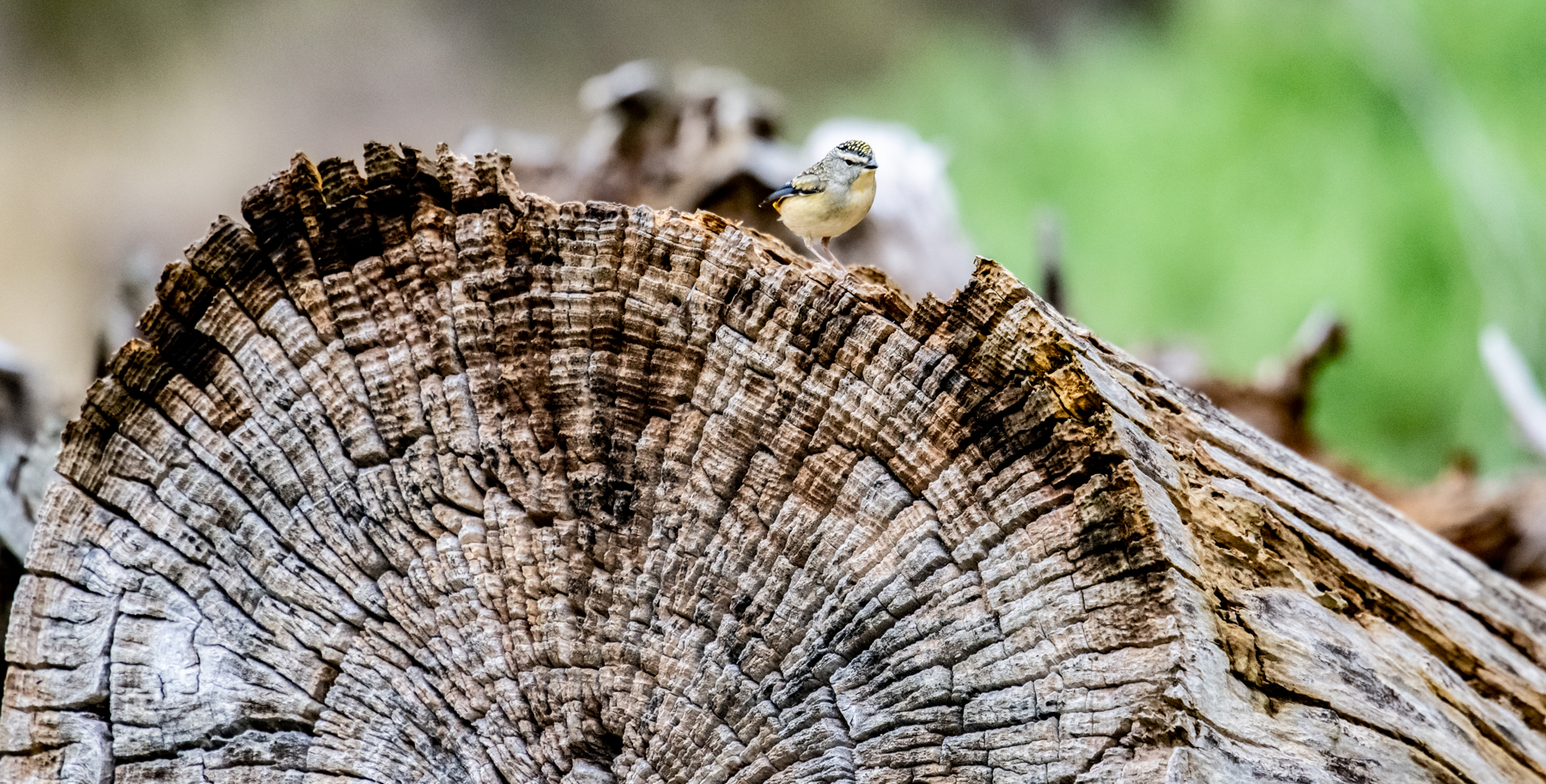
Inspiring and Supporting Photographers of Australian Birds
Spotted Pardalote
 | |||||||||||||||||||
| Photographed by | Michael Hamel-Green on Thu 17th Jun, 2021 and uploaded on Mon 21st Jun, 2021 . | ||||||||||||||||||
| Resolution | 1800x913 | ||||||||||||||||||
| Viewed | 260 | ||||||||||||||||||
| ID | 46754 | ||||||||||||||||||
| Comment | Long-lived Eucalypt, shorter living Pardalote. This tree, with its 75 plus rings, lived for at least three-quarters of a century before we cut it down. A Pardalote might live for around 3 to 6 years. Of course, the species to which each belongs are a little older. Eucalypts emerged over 53 million years ago when Australia was still joined to Antarctica in the mega-continent of Gondwana. Pardalotes and other song birds emerged several million years ago in Australia and have now been shown to be the origin of songbirds around the world. Of course, our own human species, Homo sapiens, was a late-comer on the scene, dating from some 200,000 years ago. Our role in changing or destroying the habitats for all other species is more recent still, dating from the last thousand years, and accelerating after the advent of the industrial revolution and globalization during the last four centuries. For a number of ecological reasons, Pardalote populations are declining but not as yet endangered, except for the Forty-Spotted Pardalote, now extremely rare and found only in a few spots of Tasmania and offshore islands. As zoologist, John Woinarski (https://phys.org/news/2020-11-pardalotes-unique-birds-country.html) noted recently, “Around 10% of [Pardalotes’] habitat was burned in the severe wildfires of 2019–20, with those fires most likely killing the birds directly, and leaving burned habitat unsuitable for their re-establishment for at least several years. In many parts of their range, the manner in which we have degraded and fragmented their forest and woodland habitat has benefitted a small suite of aggressive honeyeaters—the native noisy miner and bell miner—and these miners can kill pardalotes and exclude them from otherwise suitable habitat. Purposefully, incompetently or haphazardly, we have rearranged the ecology of this land to suit our needs, and in doing so have rubbed away much that was integral to the existence of many other species”. Woinarski notes that we still have a chance to save the Forty-Spotted Pardalote but “that opportunity may soon be lost, and observed: “their intermittent call can still lure me away into lives that are not my own, into different ways of knowing our country and its workings, of the damage we've done and the healing we have yet to do”. A tiny female Spotted Pardalote foraging for insects on top of some of the damage we’ve done, and a reminder, as Woinarski notes, of the “healing we have yet to do”. | ||||||||||||||||||
| Equipment | Nikon Z7ii, Nikon 300mm PF f4, TC1.7, focal length 500mm ISO 1600 1/500th f6.7 Monopod | ||||||||||||||||||
| Location | Royal Park Wetlands, Parkville, Victoria | ||||||||||||||||||
| Keywords | female, adult | ||||||||||||||||||
| You already have an outstanding request to download this image for non-commercial purposes. You may cancel this request by clicking on the button below and waiting for confirmation that your request has been noted. When you have selected all the images that you require, go to 'My Download Requests' (under Photo Gallery) and submit your request by clicking 'Edit/Submit' and filling out the details. You will be advised of the result by email. Note that cookies MUST be enabled for this to work. | |||||||||||||||||||
| You may request download of this image for non-commercial purposes. A request that meets the usage rights of this image will be automatically approved; a request that does not meet the usage rights will be refused, but may (at the Download Manager's discretion) be referred to the photographer. The usage rights of this image are: Any non-commercial use by any requestor, including personal use. For further details of image usage rights, see here. Request the image by clicking on the button below and waiting for confirmation that your request has been noted. When you have selected all the images that you require, go to 'My Download Requests' (under Photo Gallery) and submit your request by clicking 'Edit/Submit' and filling out the details. You will be advised of the result by email. Note that cookies MUST be enabled for this to work. | |||||||||||||||||||
| COMPUTED.html: width="1800" height="913" COMPUTED.Height: 913 COMPUTED.Width: 1800 COMPUTED.IsColor: Not printable COMPUTED.ByteOrderMotorola: Not printable COMPUTED.ApertureFNumber: f/6.7 COMPUTED.Thumbnail.FileType: Not printable COMPUTED.Thumbnail.MimeType: image/jpeg IFD0.Make: NIKON CORPORATION IFD0.Model: NIKON Z 7_2 IFD0.XResolution: 5000/centimeters IFD0.YResolution: 5000/centimeters IFD0.ResolutionUnit: centimeters IFD0.Software: Adobe Photoshop Lightroom Classic 10.2 (Macintosh) IFD0.DateTime: 2021:06:21 17:15:03 IFD0.Exif_IFD_Pointer: Not printable EXIF.ExposureTime: 1/500 EXIF.FNumber: F6.7 EXIF.ExposureProgram: Aperture priority EXIF.ISOSpeedRatings: 1600 EXIF.UndefinedTag:0x8830: Not printable EXIF.UndefinedTag:0x8832: 1600 EXIF.ExifVersion: 0231 EXIF.DateTimeOriginal: 2021:06:17 10:52:48 EXIF.DateTimeDigitized: 2021:06:17 10:52:48 EXIF.UndefinedTag:0x9010: +10:00 EXIF.UndefinedTag:0x9011: +11:00 EXIF.UndefinedTag:0x9012: +11:00 EXIF.ShutterSpeedValue: 8.965784 EXIF.ApertureValue: F5.5 EXIF.ExposureBiasValue: 0 EXIF.MeteringMode: CenterWeightedAverage EXIF.LightSource: unknown EXIF.Flash: Flash did not fire. EXIF.FocalLength: 500mm EXIF.SubSecTimeOriginal: 24 EXIF.SubSecTimeDigitized: 24 EXIF.ColorSpace: Not printable EXIF.FocalPlaneXResolution: 2301.3246154785 EXIF.FocalPlaneYResolution: 2301.3246154785 EXIF.FocalPlaneResolutionUnit: Not printable EXIF.SensingMethod: Not printable EXIF.FileSource: DSC EXIF.SceneType: Not printable EXIF.CFAPattern: Not printable EXIF.CustomRendered: Not printable EXIF.ExposureMode: Automatic Exposure EXIF.WhiteBalance: Automatic White Balance EXIF.FocalLengthIn35mmFilm: 500 EXIF.SceneCaptureType: Unknown EXIF.GainControl: Not printable EXIF.Contrast: Not printable EXIF.Saturation: Not printable EXIF.Sharpness: Not printable EXIF.SubjectDistanceRange: Not printable EXIF.UndefinedTag:0xA431: 7400275 EXIF.UndefinedTag:0xA432: Not printable EXIF.UndefinedTag:0xA434: VR 300mm f/4E | |||||||||||||||||||
| |||||||||||||||||||
CONTACT US
The easiest way to contact us is by emailing us at This email address is being protected from spambots. You need JavaScript enabled to view it.
The Our People page, in the About Us section, contains email links to each of the committee members.
Copyright © BirdLife Photography 2016-23. Website design and programming by This email address is being protected from spambots. You need JavaScript enabled to view it. and This email address is being protected from spambots. You need JavaScript enabled to view it.. Website Administrator: This email address is being protected from spambots. You need JavaScript enabled to view it..


